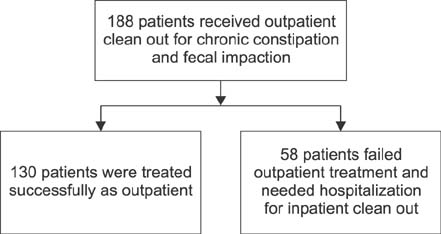Pediatr Gastroenterol Hepatol Nutr.
2018 Jul;21(3):196-202. 10.5223/pghn.2018.21.3.196.
Clinical Characteristics of Children Needing Inpatient Treatment after Failed Outpatient Treatment for Fecal Impaction
- Affiliations
-
- 1Department of Pediatrics, MetroHealth Medical Center (MHMC) affiliated with Case Western Reserve University, Cleveland, OH, USA.
- 2Division of Pediatric Gastroenterology, MetroHealth Medical Center (MHMC) affiliated with Case Western Reserve University, Cleveland, OH, USA. rgulati@metrohealth.org
- KMID: 2415598
- DOI: http://doi.org/10.5223/pghn.2018.21.3.196
Abstract
- PURPOSE
Treatment of chronic constipation and fecal impaction is usually outpatient and requires high or frequent doses of laxatives. However, there are children who fail outpatient treatments, sometimes repeatedly, and are ultimately hospitalized. We sought to compare the characteristics of the children who failed outpatient treatment and needed inpatient treatment vs those who achieved success with outpatient treatment, in an effort to identify attributes that might be associated with a higher likelihood towards hospitalization.
METHODS
In this retrospective cohort study, we reviewed the medical records of all patients aged 0 to 21 years, with chronic functional constipation and fecal impaction seen in the pediatric gastroenterology clinic over a period of 2 years.
RESULTS
Total of 188 patients met inclusion criteria. While 69.2% were successfully treated outpatient (referred to as the outpatient group), 30.9% failed outpatient treatment and were hospitalized (referred to as the inpatient group). The characteristics of the inpatient group including age at onset of 3.6±3.6 years (p=0.02); black ethnicity (odds ratio [OR] 4.31, 95% confidence interval [95% CI] 2.04-9.09); p < 0.001); prematurity (OR 2.39, 95% CI 1.09-5.26; p=0.02]; developmental delay (OR 2.20, 95% CI 1.12-4.33; p=0.02); overflow incontinence (OR 2.26, 95% CI 1.12-4.53, p=0.02); picky eating habits (OR 2.02, 95% CI 1.00-4.08; p=0.04); number of ROME III criteria met: median 4, interquartile range 3-5 (p=0.04) and 13±13.7 constipation related prior encounters (p=0.001), were significantly different from the outpatient group.
CONCLUSION
Identification of these characteristics may be helpful in anticipating challenges and potential barriers to effective outpatient treatment.
Keyword
MeSH Terms
Figure
Reference
-
1. van den Berg MM, Benninga MA, Di Lorenzo C. Epidemiology of childhood constipation: a systematic review. Am J Gastroenterol. 2006; 101:2401–2409.
Article2. Wald ER, Di Lorenzo C, Cipriani L, Colborn DK, Burgers R, Wald A. Bowel habits and toilet training in a diverse population of children. J Pediatr Gastroenterol Nutr. 2009; 48:294–298.
Article3. Chitkara DK, Talley NJ, Weaver AL, Katusic SK, De Schepper H, Rucker MJ, et al. Incidence of presentation of common functional gastrointestinal disorders in children from birth to 5 years: a cohort study. Clin Gastroenterol Hepatol. 2007; 5:186–191.
Article4. Tabbers MM, DiLorenzo C, Berger MY, Faure C, Langendam MW, Nurko S, et al. Evaluation and treatment of functional constipation in infants and children: evidence-based recommendations from ESPGHAN and NASPGHAN. J Pediatr Gastroenterol Nutr. 2014; 58:258–274.
Article5. Benninga M, Candy DC, Catto-Smith AG, Clayden G, Loening-Baucke V, Di Lorenzo C, et al. The Paris Consensus on Childhood Constipation Terminology (PACCT) Group. J Pediatr Gastroenterol Nutr. 2005; 40:273–275.
Article6. Ingebo KB, Heyman MB. Polyethylene glycol-electrolyte solution for intestinal clearance in children with refractory encopresis. A safe and effective therapeutic program. Am J Dis Child. 1988; 142:340–342.
Article7. Sethi S, Mikami S, Leclair J, Park R, Jones M, Wadhwa V, et al. Inpatient burden of constipation in the United States: an analysis of national trends in the United States from 1997 to 2010. Am J Gastroenterol. 2014; 109:250–256.
Article8. Pall H, Zacur GM, Kramer RE, Lirio RA, Manfredi M, Shah M, et al. Bowel preparation for pediatric colonoscopy: report of the NASPGHAN endoscopy and procedures committee. J Pediatr Gastroenterol Nutr. 2014; 59:409–416.9. Jordan-Ely J, Hutson JM, Southwell BR. Disimpaction of children with severe constipation in 3–4 days in a suburban clinic using polyethylene glycol with electrolytes and sodium picosulphate. J Paediatr Child Health. 2015; 51:1195–1198.
Article10. Uc A, Hyman PE, Walker LS. Functional gastrointestinal disorders in African American children in primary care. J Pediatr Gastroenterol Nutr. 2006; 42:270–274.
Article11. Bongers ME, van Wijk MP, Reitsma JB, Benninga MA. Long-term prognosis for childhood constipation: clinical outcomes in adulthood. Pediatrics. 2010; 126:e156–e162.
Article12. Cunningham C, Taylor HG, Klein N, Minich NM, Hack M. Constipation is a problem among former <750 gram birthweight (ELBW) children. Pediatr Res. 1998; 43:100.
Article13. Elawad MA, Sullivan PB. Management of constipation in children with disabilities. Dev Med Child Neurol. 2001; 43:829–832.
Article14. Malone C, Sharif F, Glennon-Slattery C. Growth and nutritional risk in children with developmental delay. Ir J Med Sci. 2016; 185:839–846.
Article15. Bernard-Bonnin AC, Haley N, Bélanger S, Nadeau D. Parental and patient perceptions about encopresis and its treatment. J Dev Behav Pediatr. 1993; 14:397–400.
Article16. Ranasinghe N, Devanarayana NM, Benninga MA, van Dijk M, Rajindrajith S. Psychological maladjustment and quality of life in adolescents with constipation. Arch Dis Child. 2017; 102:268–273.
Article17. Taylor CM, Northstone K, Wernimont SM, Emmett PM. Picky eating in preschool children: Associations with dietary fibre intakes and stool hardness. Appetite. 2016; 100:263–271.
Article18. Park M, Bang YG, Cho KY. Risk factors for functional constipation in young children attending daycare centers. J Korean Med Sci. 2016; 31:1262–1265.
Article19. Rajindrajith S, Devanarayana NM, Crispus Perera BJ, Benninga MA. Childhood constipation as an emerging public health problem. World J Gastroenterol. 2016; 22:6864–6875.
Article
- Full Text Links
- Actions
-
Cited
- CITED
-
- Close
- Share
- Similar articles
-
- Report of an Unusual Case With Severe Fecal Impaction Responding to Medication Therapy
- A Case of Recurrent Fecal Impaction
- Successful Removal of Hard Sigmoid Fecaloma Using Endoscopic Cola Injection
- An Inpatient Group Psychotherapy Model: Integrated Model led by A Psychiatrist
- Scoring system to evaluate meaningful fecal impaction in patients with lower urinary tract dysfunction with simple radiography (KUB)


